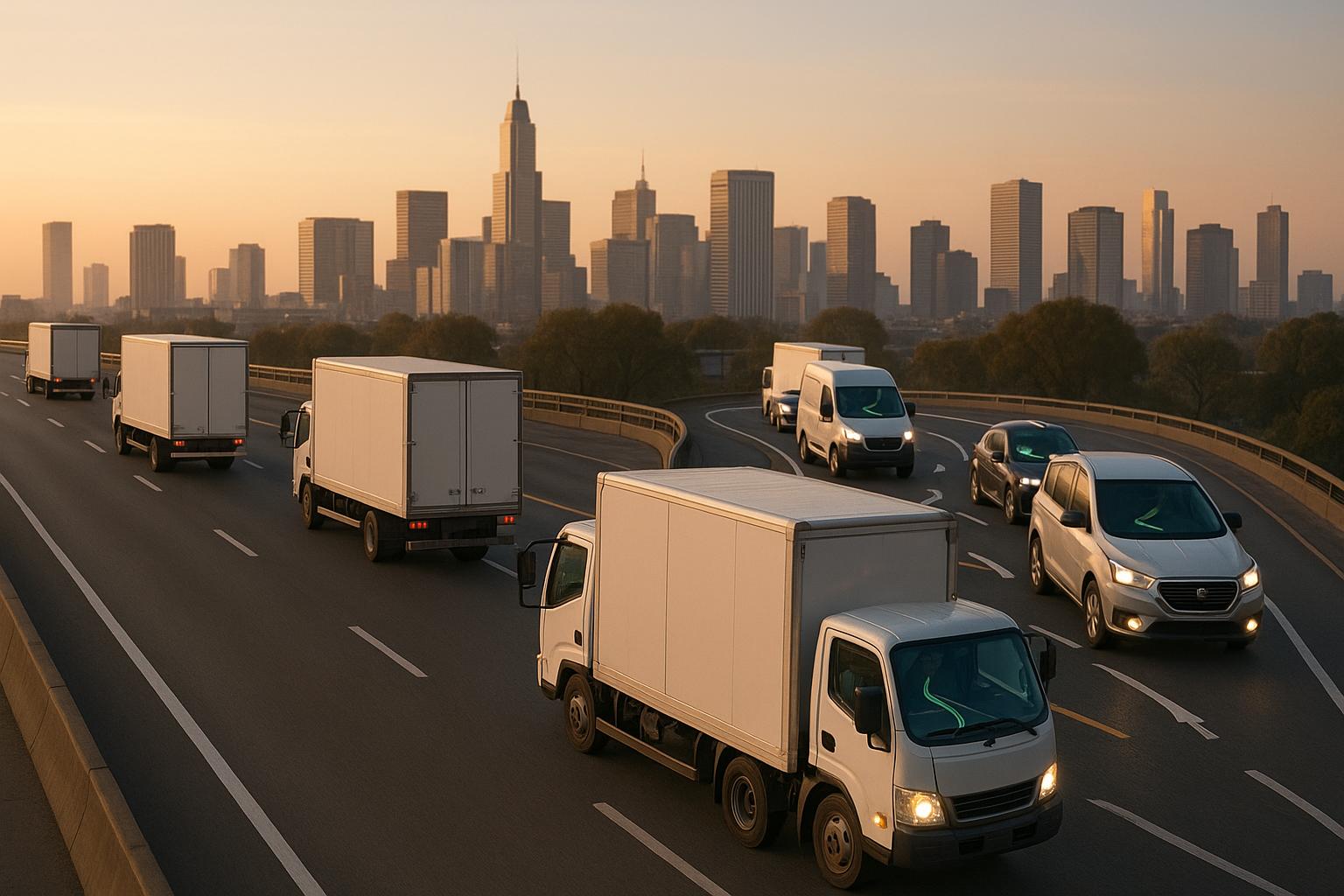Switching from manual to AI-powered route planning can save businesses up to 46.5% in operational costs, reduce fuel usage by 20%, and increase delivery capacity by 10-25%. While manual planning takes hours and struggles with real-time adjustments, AI systems optimize routes in minutes, cut labor costs, and improve accuracy.
Key Benefits of AI Route Planning:
- Time Savings: AI reduces daily planning from 2-3 hours to just 15 minutes.
- Cost Reductions: Save $16,250 annually on labor for a 10-vehicle fleet.
- Fuel Efficiency: AI improves efficiency by 20%, saving $29,000-$87,000 annually for a fleet covering 500,000 miles.
- Scalability: Manage hundreds of vehicles without adding planners.
- Customer Retention: 12% fewer late deliveries lead to better client loyalty.
- Compliance Savings: AI reduces compliance costs by 3.5x compared to manual methods.
Quick Comparison
| Aspect | Manual Planning | AI Planning |
|---|---|---|
| Time Spent | 2-3 hours daily | 15 minutes daily |
| Route Efficiency | Basic | 18% improvement |
| Fuel Savings | None | 20% reduction |
| Compliance Costs | $120,000 annually | $33,600 annually |
| Missed Deliveries | 12% more late deliveries | 75% reduction |
AI systems require upfront costs for software and setup, but businesses often recoup their investment in 6-18 months through savings and increased revenue. For example, a small delivery company saved $58,250 annually by switching to AI.
Bottom Line: AI route planning is faster, cheaper, and more accurate than manual methods, making it a smart investment for businesses of all sizes.
AI Revolutionizes Delivery Route Planning: Smarter, Faster, Better
Direct Costs: Manual vs AI Planning
When comparing manual and AI-based route planning, the difference in operational costs becomes clear. These costs directly influence a business's bottom line, as shown in various case studies.
Time Spent Planning Routes
Manual route planning takes a lot of time. For a fleet of 10 vehicles, it usually requires 2-3 hours daily, with labor costs of about $25 per hour. AI tools like Routific, however, can handle the same task in just minutes.
| Planning Method | Daily Planning Time | Annual Labor Cost* | Time-Related Savings |
|---|---|---|---|
| Manual Planning | 2-3 hours | $19,500 | - |
| AI Planning | 15-20 minutes | $3,250 | $16,250 |
| *Based on planner rate of $25/hour |
Fuel Usage and Route Length
AI-powered route optimization doesn’t just save time - it also cuts down on fuel costs. By improving fuel efficiency by 20% and optimizing routes, businesses see major savings. For a fleet covering 500,000 miles annually, this translates to $29,000-$87,000 in fuel savings. For operations with 50 vehicles, optimized routing can reduce daily mileage by 750 miles, saving $600 per day.
Real-time adjustments also contribute significantly. For 50 vehicles traveling 100 miles daily, cutting 750 miles saves $150 in fuel and $450 in labor each day. These savings, combined with reduced planning time, create a powerful ripple effect on overall costs.
Staff Costs for Route Management
AI systems also streamline workforce costs. While a human planner can manage 20-30 vehicles, AI solutions can scale to hundreds of vehicles without a proportional increase in expenses.
For example, scaling from 30 to 300 vehicles would require nine additional human planners, costing $450,000 annually. AI, on the other hand, incurs minimal additional costs. Similarly, for 50 drivers working five overtime hours weekly at $30/hour, AI can eliminate much of this overtime, saving between $97,500 and $136,500 annually.
Indirect Costs and Future Effects
AI planning isn't just about cutting labor and fuel costs - it also helps businesses avoid larger operational risks:
Lost Sales and Client Loyalty
Relying on manual planning leads to 12% more late deliveries compared to AI-based systems. Late deliveries directly impact customer loyalty, with businesses experiencing a 5-8% drop in retention rates when using manual methods.
Here's a quick example: A company with 1,000 clients, charging $50 per client each month, could lose $30,000 annually if just 5% of its customers leave. And as fleet size grows, these losses multiply.
Mistakes and Legal Issues
Manual planning doesn't just risk late deliveries - it also increases exposure to costly compliance issues. AI systems achieve 95-98% accuracy, compared to 80-85% for manual methods. This difference can significantly impact compliance costs:
| Planning Method | Accuracy Rate | Annual Compliance Costs* | Potential Savings |
|---|---|---|---|
| Manual Planning | 80-85% | $120,000 | - |
| AI Planning | 95-98% | $33,600 | $86,400 |
| Based on a mid-sized logistics company case study |
With manual planning, compliance costs are 3.5 times higher than those of AI systems. In transportation, poor planning can lead to hours-of-service violations, with fines reaching up to $16,000 per incident. The lower accuracy of manual methods only amplifies these risks.
When you factor in hidden costs like customer losses, compliance fines, and scaling challenges, the true cost of manual route planning becomes clear. AI solutions offer a smarter way to manage these risks while keeping costs under control.
sbb-itb-7020db0
AI System Implementation Costs
Switching to AI-based route planning involves several initial expenses that need careful evaluation. These upfront costs are offset by operational savings, often allowing businesses to recoup their investment in 6 to 18 months through better efficiency and reduced overhead.
Software Costs and Subscription Plans
| Fleet Size | Monthly Cost | Annual Cost | Features Included |
|---|---|---|---|
| Up to 10 vehicles | $99 | $1,188 | Basic optimization, GPS tracking |
| Up to 50 vehicles | $299 | $3,588 | Advanced routing, real-time updates |
| 50+ vehicles | Custom pricing | Varies | Enterprise features, API access |
Subscription-based models, like those offered by Routemize, are often 40-60% more affordable than manual planning, which can cost $20,000 to $30,000 annually in labor. These plans also include updates and support, adding long-term value.
Setup and System Connection Costs
Initial setup costs ensure businesses can start saving on fuel, labor, and compliance, as highlighted in earlier sections.
| Implementation Component | Cost Range |
|---|---|
| Software configuration | $1,000-$5,000 |
| Hardware upgrades | $500-$2,000 per vehicle |
| System integration | $3,000-$15,000 |
Preparing data for the system may add $5,000 to $20,000 to the initial costs, but this step is crucial for accurate route optimization. The implementation process typically takes anywhere from 2 weeks to 3 months.
Employee Training Costs
| Training Element | Cost Range |
|---|---|
| Instructor-led sessions | $500-$2,000 per day |
| E-learning modules | $50-$200 per employee |
| Temporary reduced productivity | $200/day per employee |
Training plays a key role in achieving efficiency. Most businesses see 15-30% workflow improvements within six months. Employees generally return to full productivity within a month of completing their training.
Cost Analysis with Examples
Cost Comparison Data
Switching to AI-powered solutions can lead to a noticeable drop in operational expenses. A detailed look at cost profiles shows businesses often see a 46.5% reduction in total costs after adopting AI systems.
| Cost Category | Manual | AI | Savings |
|---|---|---|---|
| Missed Deliveries | $100k | $25k | 75% |
| Total Operational Costs | $200k | $107k | 46.5% |
"Companies using manual processes spend an average of 115 hours per month on routing-related tasks, compared to just 27 hours for those using AI solutions", reports a recent Aptean study.
Small Business Example
Even smaller businesses can benefit significantly, as shown by Fresh Foods Direct, a grocery delivery service with five vehicles in Portland, Oregon. Their switch to AI-based route planning highlights the financial impact of this change.
Initial Investment:
- One-time setup and training: $1,000
Annual Savings:
- $8,250 in direct cost reductions
- Lower vehicle wear due to optimized routes
- $50,000 saved by avoiding peak-season revenue losses
One standout improvement was their ability to handle the holiday season efficiently. With AI, Fresh Foods Direct kept delivery times consistent without hiring temporary planners, who previously cost $20/hour. This adjustment alone helped them avoid losing $50,000 in revenue during the busiest time of the year.
Conclusion: Making the Choice
Cost Savings with AI
AI doesn't just cut costs - it reshapes how businesses manage expenses. For example, Fresh Foods Direct reported saving $58,250 annually by implementing AI-driven solutions. Here's a quick breakdown of potential savings:
| Category | Savings |
|---|---|
| Vehicle Maintenance | Up to 20% |
| Delivery Capacity | 10-25% |
These savings aren't just numbers; they reflect real improvements in efficiency and resource allocation.
Steps to Switch to AI
- Audit Current Routing Costs: Evaluate key metrics like planning hours, fuel expenses, and delivery success rates to understand where you're spending the most.
- Pilot Program Implementation: Start small by focusing on areas with the highest costs, as identified in your audit. Test AI's impact on these metrics.
- Full Integration: Once the pilot proves successful, scale the system across your operations. This approach mirrors the efficiency gains seen in managing 300 vehicles with minimal extra effort.
Switching to AI route planning is more than a cost-cutting measure - it's an investment in efficiency and scalability. A well-structured rollout can deliver quick returns and set the stage for long-term success.


